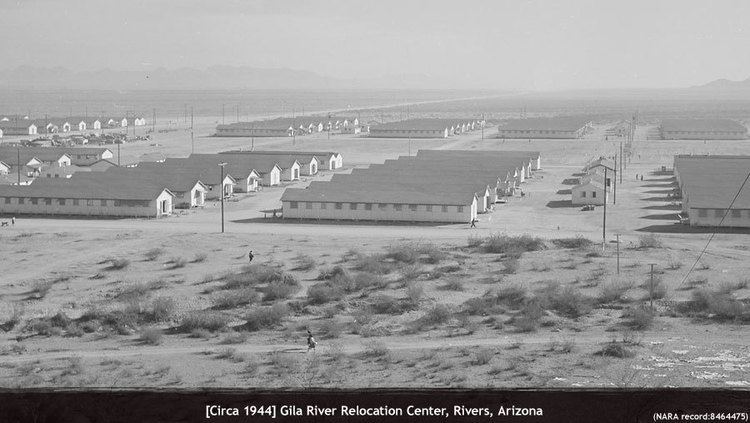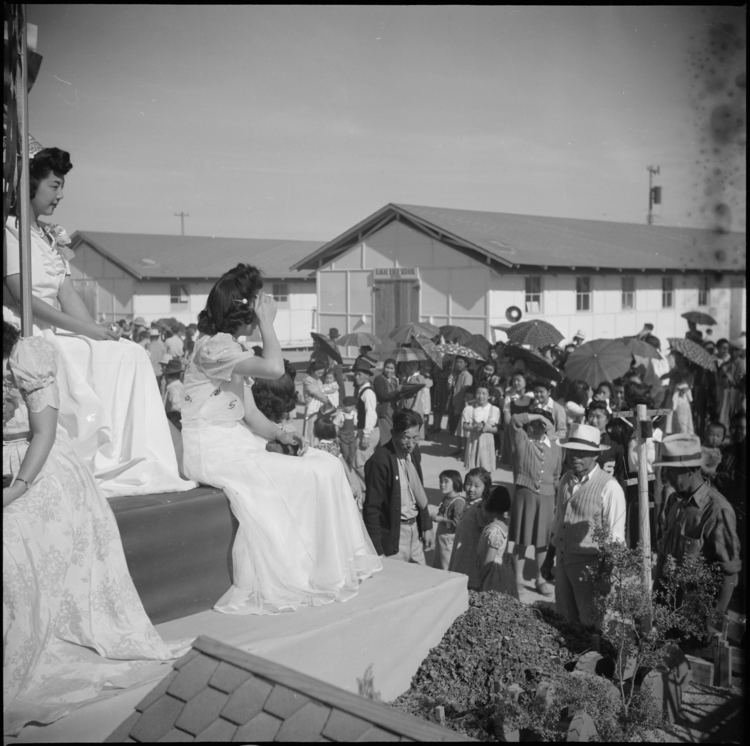Time zone MST (no DST) (UTC-7) | Area 6.1 km² | |
 | ||
Gila river war relocation center
The Gila River War Relocation Center was an internment camp built by the War Relocation Authority (WRA) for internment of Japanese Americans during the Second World War. It was located about 30 miles (48.3 km) southeast of Phoenix, Arizona.
Contents

History
The relocation center was located on the Gila River Indian Reservation, near an irrigated agricultural center. It comprised two separate camps, named 'Canal' and 'Butte'. Construction began on May 1, 1942, over the strong objections of the reservation's American Indian government. The official opening took place less than two months later, on July 20. Canal Camp closed on September 28, 1945. Butte Camp was shut down on November 10, 1945 and the Gila River Internment Center was officially closed on November 16, 1945.

Gila River received internees from California (Fresno, Sacramento, and Los Angeles). In addition, it took in 2,000 people from the Jerome War Relocation Center in Arkansas when that facility closed in 1944. It became Arizona's fourth-largest city, with a peak population of 13,348.

Some of the intended internees died en route to Gila River or shortly after arrival in the harsh desert environment. One of these was the mother of Iva Toguri, the American woman of Japanese descent who was later condemned as "Tokyo Rose" and convicted of treason due to perjured testimony.
Gila River was considered one of the least oppressive camps of its kind. It had only a single watchtower, and its fences were among the very few that lacked barbed wire. The administrators of the camps seemed to care for the evacuees, and allowed them access to the amenities of Phoenix, and recreational activities such as sports and arts. Butte camp contained a 6,000-seat baseball field, designed by Kenichi Zenimura, a professional baseball player, and considered to be the best in the WRA system. Internees also built a theater for plays and films, built playgrounds, and planted trees. Gila River had a communal medical facility at Butte Hospital. Canal Camp had 404 buildings with 232 barracks and 24 separate schoolhouses. Butte Camp contained 821 buildings with 627 residential barracks. These barracks were made of wood and fireproof shingles that blocked out the desert heat. Each barrack was made to house four single families in separate apartments. Unfortunately, the camp exceeded its capacity: it was designed for 10,000 residents, but held over 13,000. Because of this some families resorted to living in the mess hall or recreation buildings and used blankets as makeshift walls. Water shortages also plagued the camp, and poisonous rattlesnakes and scorpions kept Butte Hospital extremely busy.
As the land for the camp sites is owned by the Gila River Indian Tribe and is considered sacred by them, public access to the sites is currently restricted. Although all the main structures are long gone, some artifacts, such as the road grid, concrete slab foundations, manholes, cisterns, several rock alignments and dozens of small ponds, remain today.
On December 21, 2006, President Bush signed H.R. 1492 into law guaranteeing $38,000,000 in federal money to restore the Gila River relocation center along with nine other former Japanese internment camps. "H.R. 1492".
